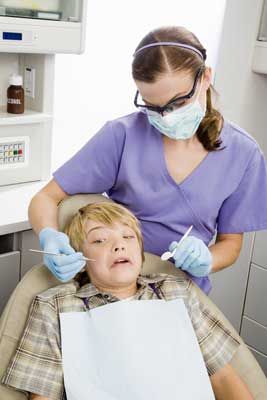Calming dental anxiety
You walk into the reception area and call your patient’s name. Right away, you see the fear in her face as she rises gingerly from her seat. She’s nervous, she tells you, and really doesn’t want to be here.

You walk into the reception area and call your patient’s name. Right away, you see the fear in her face as she rises gingerly from her seat. She’s nervous, she tells you, and really doesn’t want to be here. Even before she reaches the exam room, you can predict the scenario: a tense body that flinches every time you reach for an instrument; a tight mouth that’s extra sensitive and leaves little room for maneuvering. There’s no doubt about it, you have a difficult procedure ahead of you.
Dental anxiety is a common patient reaction that ranges from slight to severe. There are no statistics on what percentage of patients experience dental anxiety, but most practitioners have seen their share. A general term that can include both dental fear (a reaction to a previous experience) and dental phobia (a much stronger form of fear possibly stemming from a traumatic experience), dental anxiety poses significant challenges for patients and dental hygienists alike.
These challenges start with the physiological changes-increased blood pressure, accelerated heart rate and elevated respiration rate-that many anxious patients experience. In addition to raising concerns about your patient’s well-being, such spikes also lead to problems with administering local anesthetic. But the effects of dental anxiety often linger well after your patient finishes his or her appointment. That’s because anxious patients usually require more time and can easily put you behind schedule, leaving you to play catch-up for the rest of the day.
The Relaxation Solution
As a dental hygienist with 30 years of experience and a certified hypnotherapist since 1999, I’ve found an effective way to reduce dental anxiety-guided relaxation. Guided relaxation exercises are easy to employ with minimal training and require no special equipment. Best of all, they are natural, safe and-unlike most sedatives-have no side effects.
I discovered guided relaxation many years ago as I explored ways to bring more calm into my personal life. Finding myself growing tense around anxious patients, I decided to apply relaxation techniques to my professional life, too. As I incorporated these simple exercises into my practice, I immediately noticed a difference-and so did my patients. Breezing by the front desk after their procedures, formerly anxious patients commented on how relaxed they felt and requested future appointments with me. I even had some patients insist they were coming in just for the relaxation!
As an added bonus, I found that as I helped my patients release their anxiety, I grew calmer too.
Based on the principles of hypnotherapy, guided relaxation uses breathing and visualization exercises to trigger positive physiological changes in the body. Here is how it works. First, I invite my anxious patient to recline comfortably in her chair and focus on her breath. The resulting increase in oxygen levels causes brain waves to move from the faster beta state to the slower alpha state. In response, the patient’s heart rate slows, respiration decreases and muscle tension is released.
I then use calming imagery, such as a serene beach setting, to support further relaxation. For some patients, I might tailor the imagery to assist in general relaxation. When doing so, I look for signs of success in a lower respiration rate, a loosening of the mouth or a more relaxed hand grip. For other patients, I might use visualization to help address issues such as gagging, salivary output or even bleeding. At the same time, I can help the patient become open to the suggestion of a positive dental experience now and in the future.
Boost Your Practice
Guided relaxation can be good for your patients in many ways. Relaxed patients will experience less discomfort and require less anesthesia in addition to feeling more at ease during their visits. But you may be pleasantly surprised at how your practice will benefit, too. By not spending extra time with anxious patients, you can stay on schedule. Procedures become less complicated. Relationships between patients and staff improve. You remain more composed during your busy day.
Guided relaxation can boost the vitality of your practice in the long-term, too. Incorporating these simple exercises allows you to broaden your scope of care- because a relaxed mind is more open to suggestions than one that is tense and worried. You’ll be more effective at helping patients adopt positive lifestyle changes, such as quitting smoking, losing weight, and managing diabetes, that will improve both oral and general health.
Finally, becoming skilled in the art of relaxation can mean an increase in referrals for your practice. As formerly anxious patients spread the word about positive experiences at your office, you might just develop a reputation as the “relaxing dental hygienist.” Building this niche will no doubt mean good things for your practice’s bottom line, but it might also re-ignite the spark that drew you to the profession of dental hygiene in the first place-the passion for helping others enjoy greater health and well-being.
Training in Guided Relaxation
Training in relaxation techniques can be as easy as finding an adult education class in your community or listening to instructional CDs. If you’re looking for more intensive training, consider a certification course in hypnotherapy or guided imagery. Whether you simply want to make your current practice run more smoothly or you’re ready to take your career to a whole new level, relaxation is a solution worth pursuing.
Jackie Foskett, RDH, BS, is a Certified Hypnotherapist and founder of Healing Hypnotherapy who works in the Seattle area. Bringing the benefits of guided relaxation to the dental industry, she conducts “Calming Dental Anxiety” trainings for dental professionals. Jackie officially retired from the clinical practice of dental hygiene in 2006, but continues to temp on a regular basis. For more information about Jackie, visit www.HealingHypnotherapy.com.